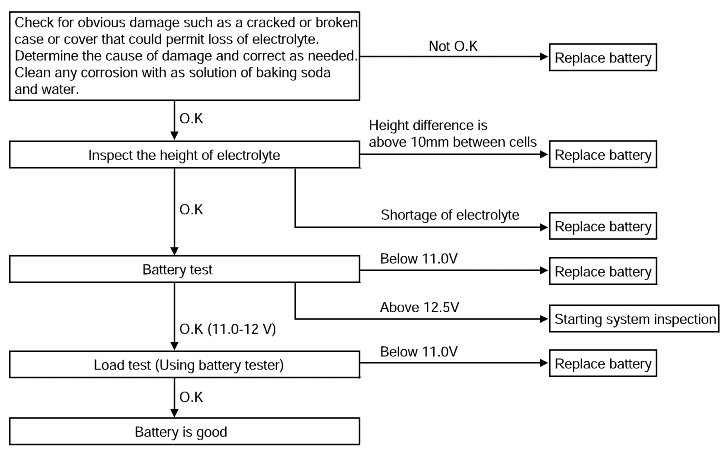

Item | Trouble | Cause | Remedy | Responsibility | |
User | Manufacturer | ||||
* Battery terminal damage | * Carelessness | ||||
* Over tightening the battery cable | Replace | O | |||
Cover Breakage | * Carelessness | Replace | O | ||
* Electrolyte leakage | |||||
- Cover breakage | * Carelessness | Replace | O | ||
- Cover leakage | * Bad cover seal | Replace | O | ||
2. Electrolyte height inspection | * Electrolyte height between cells is over 10mm | * Cell shorted electrically * Vaporization caused by excessive temperature | Replace Replace | O | O |
* Shortage of electrolyte | * Electrolyte loss caused by over-charge | Replace | O | ||
3. Voltage inspection | 1. Battery voltage >13.2V | 1. Over charge | Replace * Check the electric system | O | |
2. 12.5V < Battery voltage < 12.9 | 2. Normal | ||||
3. 12.0V < Battery voltage < 12.4V (Simple discharge) | 1. Insufficient charge | * Battery Load Test (Refer to Load Test below) | O | ||
4. 11.0 V <Battery voltage <12.0V (Over discharge) | 2. Internal failure | O | |||
5. Battery voltage : 11.0V or less | 1. Charge condition failure | Replace | O | ||
2. Battery discharged for a long period | O | ||||
3. Internal circuit open | O |
When discharging the battery during 15 seconds at half currency of Cold Cranking Power (CCP), the voltage of the battery should be as shown below.
Ambient Temperature | Voltage |
above 20°C | 9.6V |
~ 18°C | 9.5V |
~ 10°C | 9.4V |
~ 4°C | 9.3V |
~ -1°C | 9.1V |
~ -7°C | 8.9V |
~ -12°C | 8.7V |
When the voltage is not within specification, repeat the load test again, and re-charge.
If the battery is left alone for 2 hours after re-charging and its output is over 12.5V, and the voltage after a load test is over the standard value,the battery can be used.

Item | Trouble | Cause | Remedy | Responsibility | |
User | Manufacturer | ||||
* Battery terminal damage | * Carelessness | ||||
* Over tightening the battery cable | Replace | O | |||
Cover Breakage | * Carelessness | Replace | O | ||
* Electrolyte leakage | |||||
- Cover breakage | * Carelessness | Replace | O | ||
- Cover leakage | * Bad cover seal | Replace | O | ||
2. Electrolyte height inspection | * Electrolyte height between cells is over 10mm | * Cell shorted electrically * Vaporization caused by excessive temperature | Replace Replace | O | O |
* Shortage of electrolyte | * Electrolyte loss caused by over-charge | Replace | O | ||
3. Voltage inspection | 1. Battery voltage >13.2V | 1. Over charge | Replace * Check the electric system | O | |
2. 12.5V < Battery voltage < 12.9 | 2. Normal | ||||
3. 12.0V < Battery voltage < 12.4V (Simple discharge) | 1. Insufficient charge | * Battery Load Test (Refer to Load Test below) | O | ||
4. 11.0 V <Battery voltage <12.0V (Over discharge) | 2. Internal failure | O | |||
5. Battery voltage : 11.0V or less | 1. Charge condition failure | Replace | O | ||
2. Battery discharged for a long period | O | ||||
3. Internal circuit open | O |
When discharging the battery during 15 seconds at half currency of Cold Cranking Power (CCP), the voltage of the battery should be as shown below.
Ambient Temperature | Voltage |
above 20°C | 9.6V |
~ 18°C | 9.5V |
~ 10°C | 9.4V |
~ 4°C | 9.3V |
~ -1°C | 9.1V |
~ -7°C | 8.9V |
~ -12°C | 8.7V |
When the voltage is not within specification, repeat the load test again, and re-charge.
If the battery is left alone for 2 hours after re-charging and its output is over 12.5V, and the voltage after a load test is over the standard value,the battery can be used.